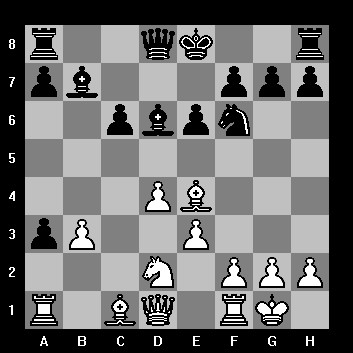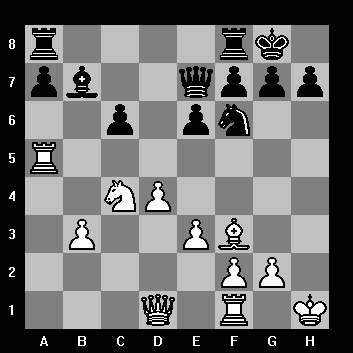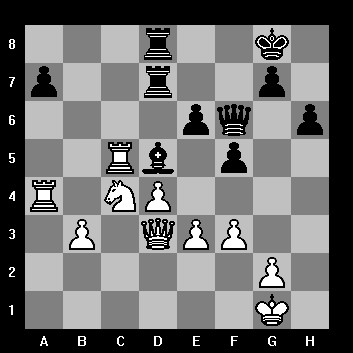27.09.2006
Game IV V.Topalov - V.Kramnik
1.d4 d5 2.c4 c6 3.Nc3 Nf6 4.e3 e6 5.Nf3 Nbd7 6.Bd3 dxc4 7.Bxc4 b5 8.Bd3 Bb7 9.a3 b4 10.Ne4 Nxe4 11.Bxe4 bxa3 12.0-0 Bd6 13.b3
All these are known in theory. Instead of the last move white used to play 13.b4 Move in the game can be traced back to a game Lugovoi-Yevseev, St.-Petersburg Championship 2003. Did Topalov study creative works of the chessplayers of our city as a preparation to this match? Yesterday he followed Solozhenkin, today he follows Lugovoi...
13...Nf6 14.Nd2 Here comes the novelty, no more kidding. 14.Bd3 c5 15.dxc5 Bc5 16.Bb5 Ke7 didn't bring white any tangible edge in a game Pogorelov-Vera, Andorra Open 2006

14...Qc7 15.Bf3 Bxh2 16.Kh1 Bd6
[it's risky to accept a pawn sacrifice now. The game might have followed the following line in this case: 14...Nxe4 15.Nxe4 Bxh2+ 16.Kxh2 Qh4+ 17.Kg1 Qxe4 18.f3 Qh4 19.Bxa3 Ba6 (activating the bishop is necessary, if 19...f6 , then 20.Bc5 a6 21.e4 Kf7 22.f4 - b7-bishop is turned to a "big pawn", while his colleague c5 occupies a strong position. Moreover the is fully in white's hands.) 20.Rf2 Bb5 21.e4 (weaker is 21.Bc5 a6 , and the bishop on b5 concretes black's weak queenside)21...f6 22.d5! exd5 23.exd5 Kf7 24.d6 d6-pawn is very strong, advantage is clearly on the white's side. 15.Bf3 An interesting positional pawn sacrifice. Judging by the speed of white's playing it we can have no doubts that all this had been prepared in Topalov's headquarters before the match. White appears to have a sufficient compensation for a pawn, but hardly more. Yet this evaluation is quite likely to turn out superficial, and white's initiative will actully grow quite serious.
15...Bxh2+ 16.Kh1 Bd6
17.Nc4 Be7 18.Bxa3 White's idea is in playing on black squares on the queenside, which will be possible after a dark-square bishops exchange. After that, as one of the possible plans, white knight will move to a5, and the pressure may be increasied on the c-file. Of course, it would be desirable to organize e4-e5, providing a nice outpost d6 for the knight, but this improvement may run into freeing c6-c5. 18...0-0 19.Bxe7 Qxe7

20.Ra5! Even stronger than 20.Na5. White rook controls the 5th horizontal preventing freeing breakthroughs c6-c5 and e6-e5. In the same time, white knight gets manoeuvering freedom, and may be eventually transferred to d3, which is an ideal square for it: from this square it aims to c5, suports b3-b4 and impedes e6-e5. 20...Rfd8 21.Kg1 Other possible useful move is - 21.Qc2 , and after likely 21...c5 22.Bxb7 Qxb7 23.Rxc5 Rd5 24.Rc1 enjoying a slight edge. 21...c5 22.Rxc5 Ne4! A very good move closing the diagonal for the bishop on f3. [Transferring a game to an ending is dubious: 22...Qxc5?! 23.dxc5 Rxd1 24.Rxd1 Bxf3 25.gxf3 , and white has advantage due to his strong passed pawn. White has some advantage after 22...Bxf3 23.Qxf3 Rac8 24.Ra5] 23.Bxe4! Now white's main trumps are a powerful wedge of his rook c5 and space advantage. It should be mentioned are up to the mark and take strong positional decisions. The probability of Topalov's still folloing his home analysis should be ruled out, at least, he play quite fast. 23...Bxe4 24.Qg4
24...Bd3 [24...Bd5 looked more natural. Now on 25.Rc1 continuation 25...Bxc4 26.bxc4 ( after 26.R1xc4 white's plus is symbolical) 26..a5, therefore 25.Ra1 is stronger] 25.Ra1 Rac8 If the wedge on c5 is taken away, the position will become equal, therefore 26.Raa5 seems to be the most logical. Purely computer-style trick 26.Rxc8 Rxc8 27.d5 stirs up certain curiousity.

26.Raa5 Rb8 Vladimir Kramnik rightly considers, that white rook is placed on a5 not the best way. If 27.Nd2, then 27...a6 is probable, securing b5 square for the bishop. However, white's position is preferrable even in this case. It should be mentioned that after 27.Ne5 black can simply take the pawn: 27...Rxb3.
27.Qd1 Be4 28.Qa1 White queen proceeds to c3, from where it will perfectly support white's pressure on the queenside defending b-pawn in the same time. 28...Rb7 29.Nd2 Bg6 30.Qc3 h6 Useful prophylaxy, black king will "feel himself ideally" on h7. 31.Ra6 Kh7 32.Nc4 Knight threatens to intervene to c6 with a tempo, this threat may be parried with 32...Be4.
32...Be4 33.f3 Move f2-f3 is good from the point of view of restricting the black bishop, but it has also a drawback - it weakens the cover of the white king. 33...Bd5 34.Nd2 an interesting gvariation is possible 34...Qh4 35.Ra1 Rdb8 36.Qd3+ f5 37.Rxd5 exd5 38.Qxf5 taking d5-pawn with more than enough compensation for an exchange.34...Rdb8 Probably this move is stronger without preliminary Qe7-h4.

35.Qd3 f5 Now a pawn sacrifice is possible 36.e4 fxe4 37.fxe4 Bxb3 The bishop got stuck on b3, but it is difficult for black to use this curcumstance, open position of his king will hamper the idea.
36.Rc3 Qh4 37.Ra1 Qg3 38.Qc2 Rf7 39.Rf1
36.Rc3 Qh4 37.Ra1 Qg3 Vladimir Kramnik is manouevering sucessfully, the game got equalized. 38.Qc2 Rf7 Prophylaxy against possible e3-e4. 39.Rf1 [an endgame arising after 39.e4 fxe4 40.Nxe4 Qg6 41.Nc5 Qxc2 42.Rxc2 is drawish.] 39...Qg6 Same line of prophylaxy against e3-e4 40.Qd3 Qg3 41.Rfc1 Opponents are biding their time.It's dificult to run any active plan.
41...Rfb7 The only active plan that could be suggested for black in this position is h-pawn advance, but Vladimir demonstrates his sheer reluctancy to take any risk in this position, and the game could become double-edged in this case.
42.Qc2 Qg5 43.Ra1 Qf6 44.Qd3 Rd7 Black is hoping to carry out e6-e5, it may be prevented by 45.Nc4. Other possible idea of creating a threat to d4-pawn by f5-f4 takes removing the black king from a comfortable position on h7, and in the game black will hardly agree to it.
45.Ra4 Rbd8 Although immediate 45...e5 cannot be refuted directly, we have to admit that a position after 46.dxe5 (46.e4?! Bc6 47.Ra6 Qd8!; 46.Ra6 Rb6 47.rxb6 axb6 48.dxe5 Qe5 49.Nc4 Bxc4=) 46...Qe5 47.Rd4 Rbd8 48.Rc5 Qe6 arouses reasonable human apprehensions. 46.Rс5 Kg8 47.Nc4

47...Bxc4?! 47...Rb7 looked very good, maintaining the tension. In this case it would have been rather white who would have had to play careful to avoid problems. 48.Raxc4?! [A courtesy in reply, now draw is inevitable. No problem for black 48.Rcc4 could pose that allowed releasing 48...e5: 49.Rc5 ed4 50.Rf5 Qh4. But after 48.Qxc4! black could not free his position, 48...f4 is not good due to 49.Re5 fxe3 (49...Rd5 fails to solve the problems because of 50.exf4 Qxf4 51.Rxe6) 50.Re6 Qf7 51.Rxe3 Qxc4 52.bxc4 Rd4 53.Ra7 Rxc7 54.Ree7. Thus, being weakend by ill-grounded exchange of the black bishop, black pawns would have become a source of serious worries.
48...f4 49.Rc6 fxe3 50.Qxe3 Rxd4 51.Rxe6 Qh4 52.Rxd4 Qxd4 53.Re8 Kh7 54.Qxd4
Draw agreed.
----------------------------------------------------
The third game of the match went on in a slow manoeuvering fight. Having encountered a good novelty on move 14, Vladimir Kramnik get bewildered, he returned to Veselin a sacrificed pawn back in the proper time, and gradually converted with unhurried subtle moves his somewhat deteriorated position to a probably slightly better one. It could be sensed that Vladimir felt himself very confident, such course of fight suits him well. The only imprecision he made on the 47th move was provoked by his striving for simplify the game. Being two pawns ahead, one can afford it, it's just very important that his simplification tendency should not play a mean trick on Kramnik in the forthcoming games. Thus, the resulting draw appears to be absolutely justified.
